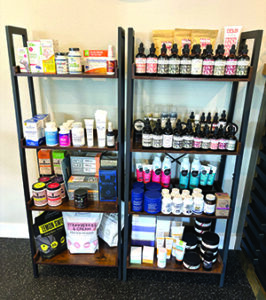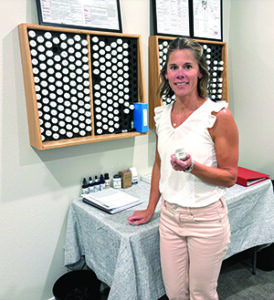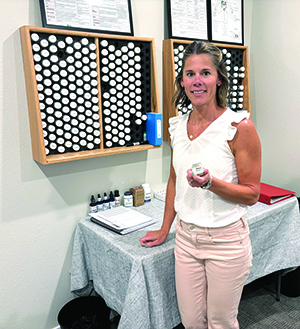
Jessica Carney shows her physical therapy room and equipment.
Jessica Carney treats her clients through traditional physical therapy as well as nutritional response testing and other modalities.
By Rich Wicks | Guthrie Center Times
Synergy is a word that describes teamwork or combined impact. Jessica Carney, owner of Synergy Wellness and Physical Therapy, explains how the term fits her practice.
“Synergy means cohesiveness, bringing parts together. So, really, I want to bring all of the pieces together for clients for optimal health,” Carney said.
At her clinic (109 N. First St. in Guthrie Center), Carney treats clients through traditional physical therapy as well as nutritional response testing and other modalities as applicable. There is no standard treatment, since each client’s condition and situation is unique.

Synergy Wellness offers many health products for sale.
Carney described her early interest in the field. After graduating high school, she realized she wanted a career in the health field. During college, she was a two-sport athlete, so she spent a lot of time in the athletic training room, and that helped steer her toward physical therapy as a career. She received a bachelor of science degree from Buena Vista University, then a doctorate of physical therapy at Des Moines University.
“As long as I can remember, I have been intrigued with the body and how it works,” Carney said.
Carney has been working as a Physical Therapist for more than 15 years and has been at her current location for just more than a year. She lives in rural Guthrie Center with her husband, Tyler, and their three kids, Cadence, 15, Dalton, 11, and Drew, 9.
Carney explained the philosophy behind her practice.
“The body was created for health and to heal itself, but sometimes we get in the way by the way we eat and the things we do,” she said.
The physical therapy services Carney offers include orthopedic rehab, pre/post-surgical rehab, sports medicine rehab, sports training, neuro rehab, acute and chronic pain, balance, gait training, geriatric care and dry needling.

Jessica Carney is a nutritional response tester.
“Dry needling is another tool in my box that we can use. We actually use acupuncture needles. It helps those tissues to relax and release. That not only helps with pain but interrupts the inflammatory cycle,” Carney said. “It can be a valuable tool to use.”
Carney is a firm believer that nutrition plays a major role in health, and that’s why she offers nutritional response testing. For those new to this, she summarized what it means.
“The nutritional response testing is newer in this area, and a lot of people haven’t been exposed to it. My one-sentence explanation is it’s a noninvasive way of determining what organs are under stress, what is stressing them, and then how we can support them.”
Another modality Carney offers is an ozone sauna.
“It’s an infrared sauna, so you get all the benefits of the infrared, but we pump ozone into it. So, basically, what we are doing is forcing oxygen into your cells,” Carney said. “There are a variety of benefits. It’s really great for wounds.”
Asked about any particularly meaningful success stories, Carney recalled a client with a very specific goal.
“There was a gentleman who had a lot of medical issues. I’d seen him for multiple things. His goal was to walk down the aisle with his daughter,” Carney said. “So, he got to do that, which was really cool.”
Because almost everyone has unresolved health issues, Carney encourages anyone to visit, but she stresses that a teamwork approach is needed.
“Everything we do here is very noninvasive. So why not try? It has to be a partnership. I don’t fix people. You don’t come here, and I fix you, and you walk out the door,” she said. “I’m going to facilitate and guide you, but, at the end of the day, you’re taking control of your health.”

The ozone sauna aids in healing.









